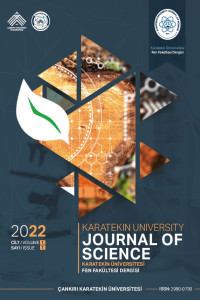Muş Lalesi’nin (Tulipa sintenisii Baker) in vitro Ortamda Soğancık Üretimi
Çalı¸smada, Anadolu’da endemik olan Muş lalesi (Tulipa sintenisii Baker)’nin yoğun, hızlı ve klonal bir çoğaltım imkânı sağlayan ve önemli bir biyoteknolojik yöntem olan doku kültürü ile çoğaltılması hedeflenmiştir. Eksplant kaynğı olarak tam çiçeklenmiş bitkilerin pistil organları kullanılmıştır. Bu amaçla Murashige ve Skoog temel besin ortamına 2,4-Diklorofenoksiasetikasit ve 6-benzylaminopürin’in (0.5, 1, 2 ve 4 mg/L) dozları kombine edilerek ilave edilmiştir. Başlangıç aşamasından sonra 4’er hafta aralıkla 2 alt kültür aşaması uygulanmıştır. Muş lalesinin soğuklama ihtiyacının karşılanması amacıyla 4 ± 11 ◦C sıcaklık ve karanlık koşullara sahip iklim kabininde 4 hafta süreyle inkübe edilmiştir. Soğuklama aşamasından sonra eksplantlar inkübasyon amacıyla 25 ± 1 ◦C sıcaklık ve 16 saat aydınlık 8 saat karanlık koşullara aktarılmıştır. Bu durumu takiben 10. hafta sonunda endojenik olarak kaynaklandığı düşünülen yoğun fungus oluşumları ile kaplı olduğu görülmüştür. 8 hafta sonra kültür kaplarında %26.7-93.3 oranlarda soğancık oluşumu gözlenmiştir. Çalışmada elde edilen sonuçlar, Muş lalesinin ticari çoğaltımının önündeki üretim engellerinin kaldırılmasında ve in-vitro çoğaltım tekniklerinin geliştirilmesinde faydalı olacaktır.
In vitro Bulblet Production of Muş Tulip (Tulipa sintenisii Baker)
The study aimed to reproduce the Muş tulip (Tulipa sintenisii Baker), which is endemic to Anatolia, by tissue culture, which is an important biotechnological method that provides intensive, rapid, and clonal reproduction. The pistil organs of the fully flowered plants were used as an explant source. For this purpose, the combined doses of 2,4-Dichlorophenoxyacetic acid and 6-benzylaminopurine (0.5, 1, 2, and 4 mg/L) were added to the Murashige and Skoog basal medium. After the initial stage, 2 subculture stages were applied at 4-week intervals. It was incubated for 4 weeks in a growth chamber with a temperature of 4±1ºC and dark conditions in order to meet the cooling needs of the Mus tulip. After the cooling stage, the explants were transferred to 25±1ºC temperature and 16 hours of light and 8 hours of dark conditions for incubation. At the end of the 10th week following this situation, it was observed that it was covered with dense fungal formations thought to be endogenously originated. After 8 weeks, 26,7-93,3 % of bulblet formation was observed in the culture dishes. The results obtained in the study will be useful in removing the production barriers to the commercial reproduction of the Mus tulip and in the development of in vitro propagation techniques
